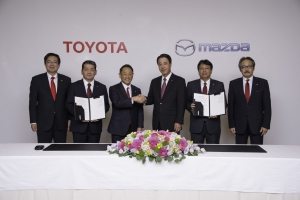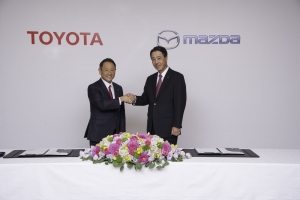News Releases
Tokyo, Japan, August 4, 2017―Toyota Motor Corporation (Toyota) and Mazda Motor Corporation (Mazda) signed an agreement today to enter a business and capital alliance, with the aim of further strengthening their lasting partnership.
Today’s agreement is a testament to the positive result of two years of collaborative and deliberate discussions between the two companies, and it is a milestone in the journey to further strengthen and accelerate the partnership in a sustainable way.
Specifically, the companies agreed to: 1) establish a joint venture that produces vehicles in the United States, 2) jointly develop technologies for electric vehicles, 3) jointly develop connected-car technology, 4) collaborate on advanced safety technologies and 5) expand complementary products.
In addition, together with the aim of advancing and strengthening their long-term collaboration, Toyota and Mazda agreed to a capital alliance arrangement that preserves independence and equality for both companies. In the capital tie-up, the two companies have agreed that Toyota will subscribe for and acquire shares to be newly issued by Mazda through a third-party allotment, and at the same time Mazda will subscribe for and acquire third-party allocation shares of treasury stock disposed of by Toyota in the equivalent amount in value to the Mazda shares. The value of the shares mutually acquired by both companies will be equivalent.
Marking the agreement, Toyota President Akio Toyoda said: “The greatest fruit of our partnership with Mazda is that we have found a new partner who truly loves cars. It has also sparked Toyota’s competitive spirit, increasing our sense of not wanting to be bested by Mazda. This is a partnership in which those who are passionate about cars will work together to make ever-better cars. It is also the realization of our desire to never let cars become commodities.”
Representing Mazda, President and CEO Masamichi Kogai said: “Nothing would please me more than if, through this alliance, we can help to energize the auto industry and create more car fans by bringing together two competitive spirits to spur each other on, leading to innovations and fostering talent and leaders.”
The auto industry increasingly faces great challenges, including stricter environmental and safety regulations for new vehicles and the entrance of competitors from other industries, as well as the diversification of mobility-related businesses. With the future of the industry in mind, in addition to leveraging their individual strengths to further improve technologies and reinforce their business foundations, Toyota and Mazda aim to deepen collaboration and achieve sustainable growth through their partnership, rising to face and overcome these pressing challenges.
On May 13, 2015, Toyota and Mazda entered an agreement to build a continuous partnership that would mutually benefit the companies in such forms as leveraging the resources of both companies and complementing each other’s products and technologies toward the goal of making more-appealing cars. Since then, both companies have discussed various areas to explore, based on the principle of building an equal and favorable relationship in the long term.
Over the medium- to long-term, the two companies will build a favorable relationship that respects the autonomy and equality of each party and works toward success with the agreed joint projects. With the aim of creating new types of value for future mobility, they will accelerate and enhance bilateral cooperation as long-term partners and contribute to the development of a sustainable society by exceeding customers’ expectations.
Details of the agreement on business alliance
1) Establish a joint venture that produces vehicles in the U.S.
As part of the new alliance, Toyota and Mazda have agreed to explore establishing a joint venture plant in the U.S. with equal funding contributions. The plant would have an estimated annual production capacity of approximately 300,000 units. Pending approvals and authorization by relevant government agencies, the companies will begin to examine detailed plans with the goal to starting operations of the new plant in 2021. The plant will require a total investment of approximately 1.6 billion U.S. dollars, and will create up to 4,000 jobs. In addition to the collaboration in product and technology areas that the companies have enjoyed thus far, Toyota and Mazda intend to improve competitiveness in manufacturing through this new production collaboration.
At the new plant, Mazda expects to produce cross-over models that Mazda will newly introduce to the North American market, and Toyota plans to produce the Corolla for the North American market.
By producing vehicles in the U.S., Mazda aims to build a production structure to further grow in North America. These activities will allow the company to more quickly respond to its customers’ needs depending on the region and model.
By further increasing its production capacity in the U.S., Toyota is to further pursue management that is closer to the region, as a measure to improve its response to the growing North American market. At Toyota’s new plant in Guanajuato, Mexico, which is currently under construction, Toyota plans to produce the Tacoma, instead of the Corolla. There will be no substantial impact on Toyota’s investment and employment plan there.
2) Jointly develop technologies for electric vehicles
With increasing demand and expectations for electric vehicles worldwide, Toyota and Mazda are to explore joint development of technologies for the basic structure of competitive electric vehicles, mobilizing and exchanging expertise freely and actively. These technologies will allow the companies to respond quickly to regulations and market trends in each country. Specific details of the collaboration will be determined as the companies work together going forward.
3) Jointly develop connected technology and collaborate on advanced safety technologies
Toyota and Mazda will work together to jointly develop technologies for onboard multimedia infotainment systems in preparation for increased use of in-car information technologies and the increasing demand for connected technologies. In addition, Toyota will cooperate with Mazda in Toyota’s vehicle-to-vehicle (V2V) and vehicle-to-infrastructure (V2I) technologies with the ultimate goal of creating a mobile society devoid of accidents.
4) Expand complementary products
Currently, Mazda is supplying a compact sedan to Toyota in North America. In addition, Toyota is to supply a compact commercial “two-box” van to Mazda in Japan. Beyond this, the companies will further explore the possibilities of other complementary products on a global level.
Details of the capital alliance
Based on the agreement, the companies will aim to develop sustainable collaboration, maximizing the synergies of the business and capital alliance by mutually acquiring shares as stated below.
Toyota will acquire 31,928,500 shares of common stock newly issued by Mazda through a third-party allotment (shareholding ratio of 5.05% on an issued share basis after the capital increase; total value of 50 billion yen).
Mazda will, through a disposition of treasury stock through a third-party allotment to be implemented by Toyota, acquire Toyota shares that are equivalent in value to the Mazda shares (shareholding ratio of 0.25% on an issued share basis).
The two companies plan to apply proceeds from the capital increase through the third-party allotment and the disposition of treasury stock through the third-party allotment to fund, in part, capital expenditures relating to the establishment of the joint venture to produce vehicles in the U.S.
Both companies are to consider strengthening their capital alliance further, in line with the progress of their business alliance.
Schedule
1) Date of signing the agreement: Friday, Aug. 4, 2017
2) Anticipated date of share acquisition (due date of the payment): Monday, Oct. 2, 2017
# # #



